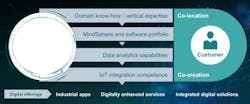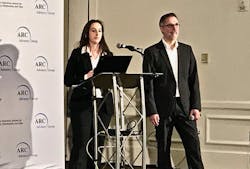Siemens Targets Co-Creation and Edge Computing
Industrial trends can sometimes be easier to follow by watching the activities of large technology organizations such as Siemens. A recent meeting with Siemens Process Automation executives Laura Coates, vice president, and Steffen Wagner, chief technology officer (CTO), highlighted the fact that industry’s interest in edge computing will not only continue, but accelerate.
While that insight is likely not surprising to Automation World readers, Siemens’ focus on co-creation—a process in which the company holds joint R&D projects with customers to target valuable digitalization efforts—is not as well-known.
During their presentation at ARC Forum 2020, Coates and Wagner said Siemens co-creation methods are focused on “developing industry-specific solutions focused on productivity, flexibility, and speed.”
Work Siemens has done with Dulux (a global producer of paints), Cathay (an industrial biotech company), and DuPont were highlighted by Coates and Wagner as examples of how Siemens works with companies using the co-creation method to target digitalization efforts that produce tangible value. (Read more about how Siemens worked with DuPont to improve valve monitoring and maintenance.)
“We develop these new applications and technologies based on our direct work with customers,” Coates said. “Through the co-creation process, you realize that how developers work to solve a problem can be very different from what a customer needs or wants. That’s why we use this agile, co-creation method to leverage input from customers.”
Lessons from these methods can then be extended to co-creation work with other customers where the feedback gained from one project can potentially be validated further through work with others.
Wagner added that the co-creation process at Siemens originated in the process side of the business but is spreading to rest of Siemens. “There aren’t many greenfield plants in the process industries,” he said, “and the co-creation is a big help to customers in brownfield plants” who have to extract more value from the systems already in place.
Speaking to how the co-creation method has affected Siemens, Coates said, “This has changed the speed at which we develop things internally. It now takes just weeks to develop applications for customers instead of months or years. We have the technologies in place that are essential for this kind of co-creational development.”
In this video, Mohamad El Naamani of Siemens explains the co-creation method.
In its effort to add to the digitalization technologies already at its disposal, Siemens made two key acquisitions in late 2019.
One of these acquisitions was Pixeom, a provider of edge computing that enables cloud service providers (in Siemens case this is Mindsphere) to package, deploy, and orchestrate applications at scale. A key capability gained from the Pixeom acquisition is the ability for Siemens to deliver updates to edge devices from a central location to keep these devices running with the latest capabilities.
Acquiring the Pixeom technologies “helps us go beyond the app layer for cloud and edge devices and enable third parties to join,” said Wagner. “We’re bringing all this together with Mindsphere for centralized management of Simatic edge hardware devices.”
Wagner added that there will be further announcement about this at Hanover Fair 2020, including information about the addition of artificial intelligence on at least one of the company’s edge devices.
The other late 2019 acquisition by Siemens relevant to the company’s co-creation work is Process Systems Enterprise (PSE), which adds digital twin technologies for the process industries to Siemens existing digital twin capabilities in the discrete and hybrid industries.
Coates noted that Siemens has been working with PSE for the past two years on the modeling and simulation of operations in the chemical, petrochemical, oil and gas, pharmaceutical, and food and beverage industries. “We [Siemens] have had digital twins for manufacturing and plant functions, now we can provide modeling and simulation in the process/design phase; such as the modeling of tanks and mathematics of chemicals.”
“PSE’s digital twin technology provides a detailed dynamic simulation of technical processes based on validated real-time process data,” said Wagner. “Using PSE’s technology at SABIC (Saudi Arabian Basic Industries Corporation, a petrochemicals manufacturer), we achieved a 2% higher yield in the company’s cracker operations.”
About the Author
David Greenfield, editor in chief
Editor in Chief

Leaders relevant to this article:


